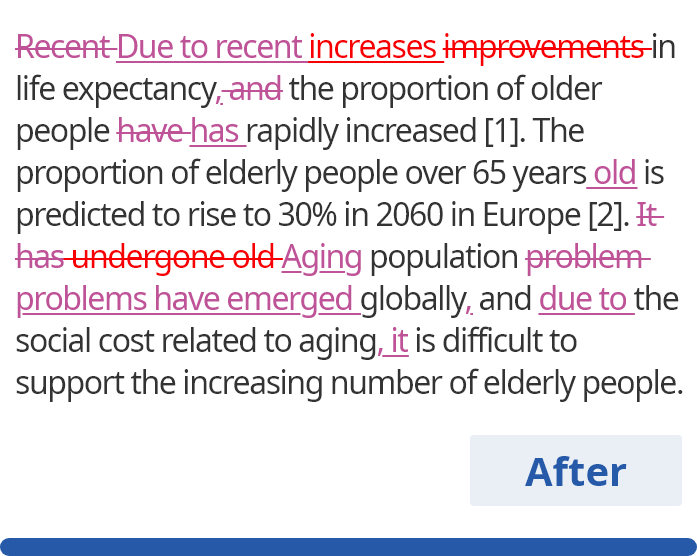连词的使用规则
连词是用来连接单词、短语或从句的词。最常用的连词包括“and”、“but”和“or”。连词包括三种类型:并列连词, 从属连词, 关联连词。
连词的种类
| 连词的种类 | 连词的作用 | 连词的例子 |
|---|---|---|
|
并列连词 |
连接在语法上对等的内容 |
for, and, nor, but, or, yet, so |
|
从属连词 |
引出从属从句 |
because, if, although, since, until, and while |
|
关联连词 |
成对出现,并连接在语法上对等的内容 |
either/or, neither/nor, not only/ but also |
目录
- 1.并列连词
- 2.从属连词
- 3.关联连词
- 4.以连词开头写句子
- 5.连词和逗号的联用规则
并列连词
并列连词连接在语法上对等的单词、短语或从句。常用的并列连词包括:for, and, nor, but, or, yet, so。 可以采用“F.A.N.B.O.Y.S.”这个便于记忆的词头拼接词记住上述七个并列连词。
- Example
- This study investigates the effects of Drug A and the placebo on the patients.
- Example
- You can choose to take the test or write an essay to pass the class.
当使用并列连词连接两个独立分句时,在并列连词前面要加逗号。
- Example
- She was unhappy with the test results, yet she refused to take the test again.
- Example
- I have only been here for one week, so I know practically nothing.
- 错误
- You should invite Mary, and Jane to the party.
- 正确
- You should invite Mary and Jane to the party.
从属连词
从属连词可以把从句和主句连接起来。从属连词用来表示因果关系、对比、时间或地点的过渡或条件关系。最常用的从属连词包括:after, although, before, even though, if, in case, till, whenever, unless, while。
表示因果关系
表示因果关系的从属连词包括:because, since, as, due to, as if。
- Example
- I could not go to class because I did not feel good.
- Example
- Due to his poor attendance, the professor had to fail him.
表示对比关系
表示对比关系的从属连词包括:although, though, whether, while, even though。
- Example
- While she plans to go to Paris for spring break, he plans to go to Tokyo.
- Example
- Although he is much younger than me, he is much smarter than most of my classmates.
表示条件关系
表示条件关系的从属连词包括:if, unless。
- Example
- Unless you leave now, you will be late.
- Example
- If he decides to take the offer, he will have to move out soon.
表示时间或地点的过渡关系
表示时间或地点的过渡关系的从属连词包括:where, everywhere, after, until, as soon as, before。
- Example
- Don't forget to clean your room as soon as you get home.
- Example
- This is the place where I grew up.
关联连词
关联连词是成对使用的单词,用来连接一个句子中的两个部分或使其彼此关联。最常用的关联连词包括:either/or, neither/nor, not only/but also。
在使用关联连词时,它们之间通常无需用逗号隔开。
- 错误
- I will either have a sandwich, or salad for lunch.
- 正确
- I will either have a sandwich or salad for lunch.
- 错误
- Neither the boy, nor his brother want to help their mother.
- 正确
- Neither the boy nor his brother want to help their mother.
但是,当关联连词(例如“not only/but also”)用于分隔两个独立分句时,连词前面应加逗号。
- 错误
- Not only did she start playing the piano at a very young age but her mother also taught her to compose music.
- 正确
- Not only did she start playing the piano at a very young age, but her mother also taught her to compose music.
以连词开头写句子
人们常说以连词开头写句子在语法上不正确。然而事实并非如此。虽然不建议在太多的句子开头使用连词(尤其在学术写作中),但适度使用是完全没有问题的,而且有些时候必须用连词开头写句子。
- Example
- She wanted to go home. But he did not want to.
- Example
- Although I do not like the restaurant, I will go if you want me to.
- Example
- Either this dress or that pair of pants is fine.
连词和逗号的联用规则
无论何种类型的连词,连词与逗号联用的规则都非常简单,即使用连词连接两个独立分句时,连词前面应该使用逗号。
- Example
- The professor explained the assignment in detail, but the students did not seem to understand it.
- Example
- The weather is nice, but I don't think we should go on the picnic.
但是,当用连词连接一个独立分句和一个从属分句时,连词前面不应该使用逗号。
- 错误
- The professor explained the assignment in detail, and gave out the workbook.
- 正确
- The professor explained the assignment in detail and gave out the workbook.
- 错误
- The weather is nice, but a little bit chilly.
- 正确
- The weather is nice but a little bit chilly.
需要注意的是,使用逗号连接两个独立分句也有例外,即如用连词连接的两个独立分句都很短,则可以省略连词前面的逗号。
- 错误
- I cooked, and he cleaned.
- 正确
- I cooked and he cleaned.
在主句前的介绍性从句、短语或单词后面要用逗号。用于这些从句或短语的连词通常包括:after, although, as, if since, when, while。
- Example
- While I do my homework, you go do the dishes.
- Example
- If you do not want to go to the party, you can stay home.
小贴士: 正确使用连词对于构建逻辑清晰的句子至关重要。如果您对连词的选择或位置把握不准,不妨访问语法检查网站来辅助写作。这些工具不仅能识别连词的误用(如错误的并列连词搭配或从属连词位置不当),还能建议更合适的连接方式,帮助您提升文章的连贯性和专业性。记住,虽然这些工具很有帮助,但系统学习语法规则仍是写出优秀文章的基础。








